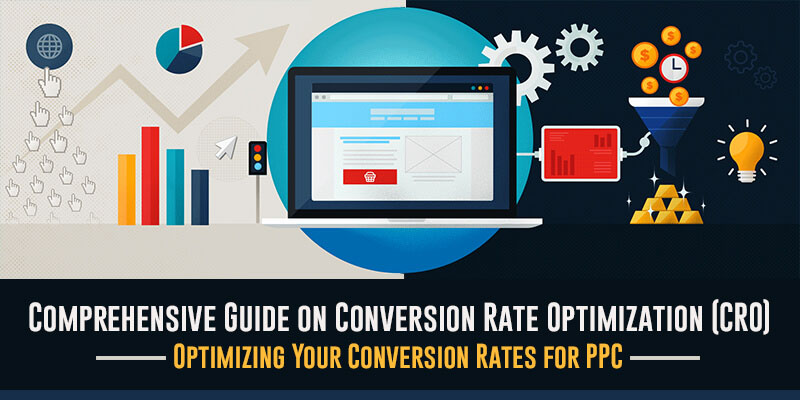I hope you enjoy reading this blog post.
If you want to get more traffic, Contact Us

Click Here - Free 30-Minute Strategy Session
Be quick! FREE spots are almost gone for this Month. Free Quote

Conversion Rate Optimisation (CRO) represents the process of enhancing a website or landing page to increase the percentage of visitors who take a desired action. This desired action could be purchasing a product, signing up for a newsletter, filling out a form, or downloading content. Leveraging CRO involves analysing user behaviour, identifying barriers affecting conversions, and implementing solutions to overcome those obstacles.
Success in CRO requires understanding audience intent, website usability, and persuasive design. It integrates elements such as effective calls-to-action, clear value propositions, and intuitive navigation. By focusing on data-driven improvements, businesses ensure their digital presence supports measurable outcomes. CRO fosters long-term growth, leveraging insights to meet goals efficiently.

Click Here – Free 30-Minute Strategy Session
Be quick! FREE spots are almost gone for this Month
Conversion rate optimisation (CRO) is essential for enhancing the efficiency of digital marketing campaigns and online business strategies. It ensures that a website or digital platform maximises the potential of its existing traffic by turning visitors into customers, subscribers, or leads. CRO reduces dependence on costly advertising by leveraging existing resources more effectively.
Improved conversion rates lead to higher revenue without drastically increasing expenses. It also enhances user experience, aligning website design and content with visitor interests. By consistently testing and analysing audience behaviour, organisations can uncover valuable insights. These insights inform strategic decisions, driving long-term growth and improving overall business performance.
Effective conversion rate optimisation (CRO) relies on tracking key metrics to evaluate performance and identify improvement areas:
Conversion Rate: Measures the percentage of users completing a desired action. Calculated by dividing conversions by total visitors. A higher rate indicates success.
Bounce Rate: Reflects the percentage of users leaving the site without interaction. A high bounce rate often signals poor user experience or irrelevant content.
Average Session Duration: Highlights how long users stay on the site. Longer sessions suggest better engagement.
Cart Abandonment Rate: Tracks users exiting without completing purchases. Important for addressing potential checkout issues.
Click-Through Rate (CTR): Measures the number of clicks on specific calls-to-action (CTAs), helping to optimise user pathways.
Identifying the target audience is pivotal to effective conversion rate optimisation. Businesses must analyse demographic details such as age, gender, education, and income levels, alongside psychographics like interests, behaviours, and purchasing habits. Conducting surveys, market research, and utilising analytics tools can help uncover these insights. Understanding motivations, pain points, and decision-making processes enables marketers to tailor content, design, and offers to meet audience expectations.
Segmenting audiences into smaller groups based on similar behaviours or preferences can refine messaging further. It is essential to continuously monitor and adapt strategies as audience needs shift over time, ensuring optimised engagement and conversion rates.
Understanding user behaviour is critical in Conversion Rate Optimisation (CRO). It provides insights into how users interact with a website, highlighting friction points and opportunities for improvement. Tracking metrics such as click-through rates, bounce rates, and session duration helps uncover patterns that impact conversion. Heatmaps and session recordings can visually demonstrate where users focus their attention or lose interest. Analysing user behaviour allows marketers to test hypothesis-driven changes, ensuring design decisions align with user needs. Behavioural data also assists in personalising content and refining messaging. By prioritising user experience, CRO efforts become more effective, fostering higher satisfaction and conversions.
To set up an effective conversion funnel, one must first identify the target audience and understand their needs. Begin by mapping out each stage of the customer journey, from awareness to decision-making. The funnel typically includes four stages: awareness, interest, desire, and action.
Define Goals Set clear objectives, such as increasing purchases, sign-ups, or downloads.
Analyse Audience Behaviour Use analytics tools to track user behaviour on the website.
Create Targeted Content Develop landing pages, ads, and call-to-action buttons tailored for each stage.
Optimise Channels Ensure email campaigns, social media, and ads align with the funnel.
Test and Refine Continuously monitor performance and adjust strategies as needed.
A refined funnel boosts engagement and drives conversions effectively.
A/B testing requires a structured approach to ensure reliable results. Start by defining clear goals, such as increasing sign-ups or improving click-through rates. Test one variable at a time to isolate its impact, whether it’s a headline, button colour, or layout.
Use a large enough sample size to achieve statistical significance, avoiding premature conclusions. Split your audience randomly to maintain impartiality. Run tests for an adequate duration to account for variations in user behaviour.
Ensure consistency by using the same tracking tools across variations. Monitor key metrics during testing to detect technical issues. Finally, apply insights from A/B tests to inform subsequent experiments, creating a continuous optimisation cycle.
Ignoring Data and Analytics Many overlook the importance of thorough data analysis, relying on intuition instead of evidence-based decisions. This can lead to misguided changes.
Neglecting Mobile Users Optimising solely for desktop users may alienate a significant portion of traffic, especially with mobile usage on the rise.
Testing Too Many Changes Simultaneously Making multiple adjustments at once makes it difficult to identify which change impacts conversions, complicating future optimisation efforts.
Unclear Call-to-Action (CTA) Websites often fail by using weak or overly complicated CTAs that confuse or dissuade users from taking action.
Focusing on Aesthetics Over Usability Prioritising design over functionality can result in a visually appealing but ineffective page that fails to convert.
Ignoring Customer Feedback Skipping user feedback can lead to assumptions that don’t address actual customer needs or pain points.
Lack of Continuous Testing Treating CRO as a one-time task rather than an ongoing process often limits the potential for growth and improvement.
To optimise your conversion rate effectively, leveraging specialised tools is essential. These tools provide insights, streamline testing, and automate processes, ensuring campaigns achieve maximum efficiency.
Google Analytics: Tracks user behaviour, traffic sources, and conversion paths.
Hotjar: Offers heatmaps and session recordings to understand visitor interactions.
Optimizely: Enables A/B and multivariate testing to analyse the performance of different variations.
VWO (Visual Website Optimizer): Supports split testing and behavioural tracking.
Funnel.io: Integrates data from various sources for detailed funnel analysis.
Mixpanel: Tracks user engagement metrics in depth.
SurveyMonkey: Creates surveys for real-time customer feedback.
Usabilla: Collects user sentiments directly from websites.
Using these tools helps refine strategies and improve decision-making in CRO campaigns.
A leading SaaS company redesigned their landing page, focusing on simpler navigation and a clear call-to-action (CTA). The updated layout, combined with the removal of distracting elements, resulted in a 58% increase in conversion rates within three weeks.
An e-commerce brand employed personalised email campaigns based on customer behaviour. They tailored product recommendations and exclusive discounts, leading to a 30% rise in sales conversions from email subscribers during a two-month period.
An online retailer ran A/B tests to analyse click-through rates on different CTA buttons. Using data-driven insights, they replaced vague phrases like “Get Started” with action-specific terms like “Explore Offers,” boosting conversions by 22%.
By simplifying order forms for mobile users and increasing page load speed, a travel booking website raised its mobile conversion rates significantly. Results showed a growth of 15% in sign-ups over six months.
Define Clear Goals Identify the primary objectives, such as increasing purchases, improving form submissions, or boosting newsletter signups.
Analyse Current Performance Use tools like Google Analytics to assess website metrics, bounce rates, and conversion paths.
Understand the Audience Conduct user research to identify target audience behaviour, pain points, and motivations.
Create Hypotheses Develop testable hypotheses based on data insights, focusing on potential improvements.
Run A/B Testing Test variations of webpages by modifying elements like CTAs, headlines, or design layouts.
Monitor Results Analyse A/B test data to determine which version performs better and adjust strategies.
Optimise Continuously Implement findings and repeat testing regularly to achieve sustained improvement.
Effective Conversion Rate Optimisation requires a structured approach to drive measurable improvements. By analysing user behaviour, businesses can identify bottlenecks in their conversion flow and refine strategies to eliminate them. Techniques such as A/B testing, user survey implementation, and heatmap analysis help to uncover actionable insights.
Ensuring a seamless user experience across devices and prioritising clear calls-to-action further optimise conversion rates. Incremental changes, supported by data, are more likely to yield sustainable growth. CRO is not a one-time activity; it demands continuous research and adaptation to evolving customer preferences and market trends.

LEAVE A REPLY